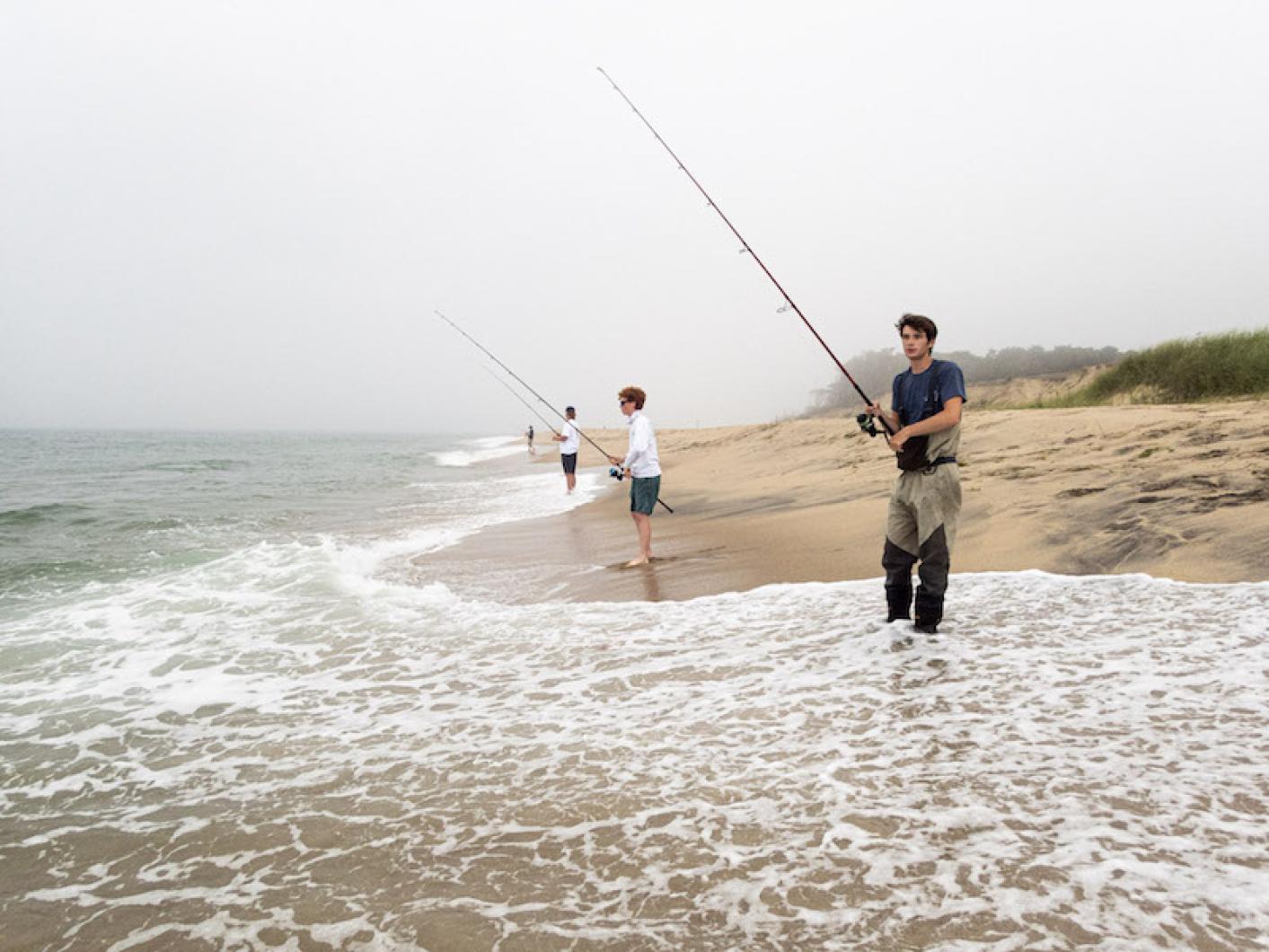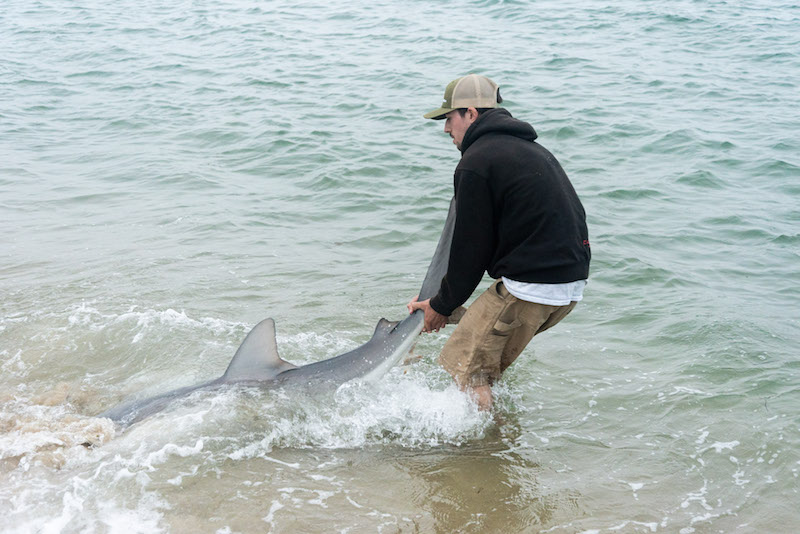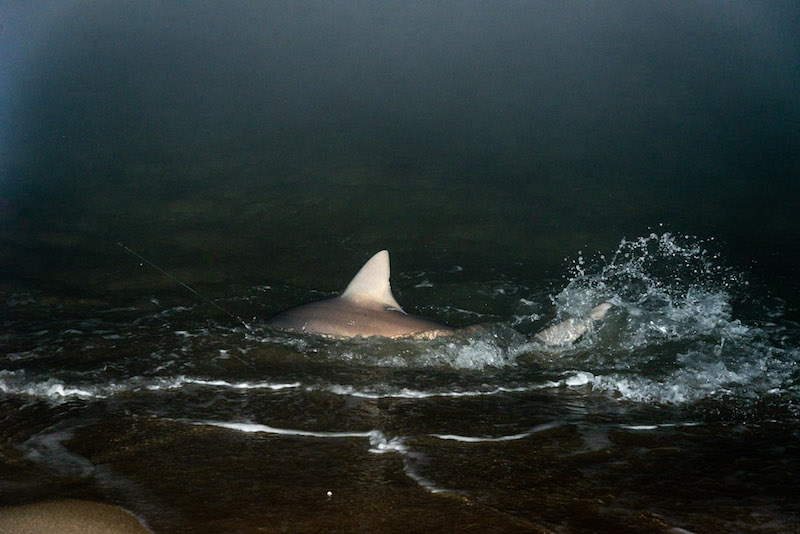Bennett MacDougall stood knee-deep in the surf at Wasque on a recent Wednesday evening, casting chunks of fresh bluefish into the rip tides, aiming to hit a shoal about 100 feet from shore. He was fishing for sharks. But unlike the other dozen or so fisherman stationed along at the famed surf-casting point, he carried with him a special canvas kit for tagging the sharks before they were released.
“It seem like all the focus is on studying great whites,” the 19-year-old said between casts. “There’s not much of a scientific focus on brown sharks . . . that’s what is really in our waters.”
Brown sharks, also known as sandbar sharks due to their preferred habitat, are one of the largest and most common coastal sharks native to the Vineyard.
The tagging operation is a small, local branch of the Cooperative Shark Tagging program, administered through the National Marine Fisheries Service in Narragansett, R.I. Operated under the Apex Predators Program, the 60-year-old program is the longest running shark tagging program in the world. The program relies heavily on recreational fishermen like Bennett for tagging and recording information.
Between 1962 and 2016, more than 290,000 fish of 52 species have been tagged through the program, according to the NMFS website. Flipping through his notes, Bennett recounted the tales of the 20 brown sharks he has tagged off Wasque this year. Nine of them he caught himself.
“If I see a shark landed, I’ll tag it,” he said. “I think it’s the most important thing we can do when fishing.”
By day Bennett sells fishing gear at Coop’s Bait and Tackle in Edgartown. But when the shop closes, he and his partner Jackson Fersen head to the Chappy shores. With over-sand vehicle access across the barrier beach from Norton Point closed for now due to nesting plovers, Bennett said he spends significant chunk of his paycheck on Chappy ferry fares. The rest, he said, goes toward more fishing gear.
When the two anglers aren’t fishing for themselves, they lead guided trips to educate and help others catch sharks for tagging and release.
“We have to stay on top of the fish,” Bennett said.
Brown sharks, though once fished heavily on a commercial scale, are now listed as threatened by the NMFS, and can no longer be kept recreationally or commercially. Though their teeth are sharp, the only reported instances of brown sharks biting humans has occurred while attempting to free a hook from their jaws, Bennett said.
“They don’t bother humans unless humans bother them,” he said.
His brown shark tagging kit includes plastic yellow tubes with steel dart heads, a tagging needle and notepad for jotting down the date, location, gear and size of the sharks caught. The tags are labeled with serialized identification numbers and the name of Coop’s tackle shop. Bennett claimed there is a discreet community of fishermen on the Cape and Islands, known to each other only through the names on their respective tags.
Dr. Greg Skomal is a senior marine biologist with the state Division of Marine Fisheries who manages the recreational fisheries program and is dedicated to tagging and studying sharks in area waters. Speaking to the Gazette by phone after a recent successful trip tagging three great white sharks off Monomoy island, Mr. Skomal underscored the importance of studying all types of sharks, not just those that attract national headlines.
He said sharks travel from the eastern coast of Florida, and with the Cape and Islands at the northern edge of their range, biological data from this region is especially important.
“Whether we’re talking great whites or brown sharks, we need to know a lot more about every species in order to manage it sustainably,” Mr. Skomal said. Speaking of the national brown shark study, he added: “This is the biggest conventional shark tagging program in the world . . . it is driven by the recreational fishing sector.”
Back at Wasque, Don Scarpone, president of the Martha’s Vineyard Surfcaster’s Association, had a shark on the line. Bennett waded into the water to help haul it onto shore. Once the shark was landed, he measured it from the tip of the nose to the fork of the tail — 61 inches — or about 100 pounds, he estimated. One fisherman held the snout steady as a tag was slipped into the side of its dorsal fin. The shark was caught, unhooked, tagged and released in under five minutes.
It was the second brown shark tagged by Bennett at Wasque that evening. He said he hoped the efforts will aid in a greater understanding of the species down the line.
“There’s not much research on these things,” he said. “It would be nice to know a little bit more.”
This story has been updated to include correct information about the shark tagging program, its history and affiliations.










Comments (3)
Comments
Comment policy »